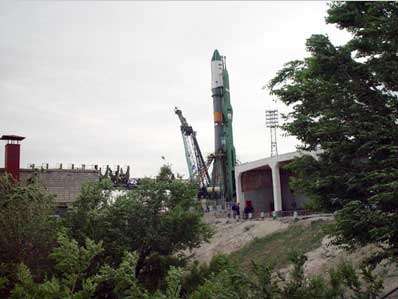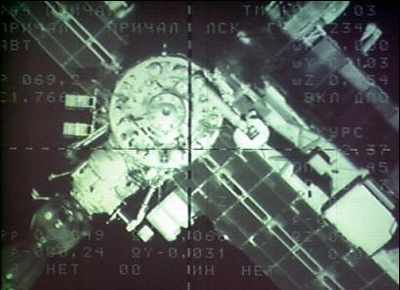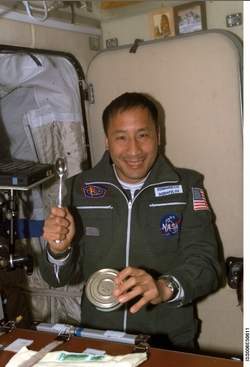Mon, Jun 09, 2003
Resupply Mission Launches As Scheduled
"It was launched successfully." That typically terse statement
from Russia's mission control Sunday as a Progress rocket lifted
off from the Baikonur Cosmodrome in Kazakhstan, carrying food,
water, fuel and even some music to the two crewmembers aboard the
International Space Station.

Lifeline
The Russian Progress and Soyuz systems are, of course, the only
current link between American astronaut Edward Lu and Russia's Yuri
Malenchenko, since the Columbia disaster Feb. 1. America's shuttle
fleet, beset by its second disaster since 1986, is currently
grounded. As a result, Lu and Malenchenko comprise the entire crew
when there would usually be three people on board the ISS - a move
undertaken to conserve supplies and reduce the number of Progress
missions to the $95 billion space station.

The Progress M-10 launched Sunday will rendezvous with the ISS
on Wednesday. The current mission also marks the first time three
Russian ships will have docked with the ISS at the same time -
including an M-10 capsule and the Soyuz escape ship currently
attached to the station. Sunday's launch will be followed by
another in late August. The August mission was to have been the
last Russian resupply flight to the ISS of the year. However,
because of the Columbia disaster, another Progress mission is now
slated for November.
Housekeeping
 During the week, Expedition 7 Commander Yuri
Malenchenko and NASA ISS Science Officer Ed Lu prepared for the
arrival of the cargo ship by rearranging items in Pirs. Malenchenko
also tested a backup system on the ISS.
During the week, Expedition 7 Commander Yuri
Malenchenko and NASA ISS Science Officer Ed Lu prepared for the
arrival of the cargo ship by rearranging items in Pirs. Malenchenko
also tested a backup system on the ISS.
In other activities throughout the week, Lu conducted sessions
with the Investigating the Structure of Paramagnetic Aggregates
from Colloidal Emulsions, or InSPACE, experiment in the
Microgravity Science Glovebox. InSPACE is a fluid materials
experiment studying how very small individual particles that are
magnetizable respond to a magnetic field that is repeatedly turned
on and off. Both crewmembers practiced operating the Station's
robotic arm, Canadarm2.
More News
Aero Linx: Model Aeronautical Association of Australia MAAA clubs are about fun flying, camaraderie and community. For over 75 years, the MAAA has been Australia’s largest fl>[...]
Touchdown Zone Lighting Two rows of transverse light bars located symmetrically about the runway centerline normally at 100 foot intervals. The basic system extends 3,000 feet alon>[...]
“Discovery and innovation are central to our mission at Virgin Galactic. We’re excited to build on our successful record of facilitating scientific experiments in subor>[...]
How To Get A Story On Aero-TV News/Feature Programming How do I submit a story idea or lead to Aero-TV? If you would like to submit a story idea or lead, please contact Jim Campbel>[...]
Student Pilot Reported That During Rotation, “All Of A Sudden The Back Of The Plane Kicked To The Right..." Analysis: The student pilot reported that during rotation, “>[...]
 ANN's Daily Aero-Linx (05.02.24)
ANN's Daily Aero-Linx (05.02.24) ANN's Daily Aero-Term (05.02.24): Touchdown Zone Lighting
ANN's Daily Aero-Term (05.02.24): Touchdown Zone Lighting Aero-News: Quote of the Day (05.02.24)
Aero-News: Quote of the Day (05.02.24) ANN FAQ: Contributing To Aero-TV
ANN FAQ: Contributing To Aero-TV NTSB Final Report: Cirrus Design Corp SR20
NTSB Final Report: Cirrus Design Corp SR20





